by Dr. Michael Wisdom, Research Biologist, USDA Forest Service Pacific Northwest Research Station, La Grande OR US and Dr. Ricardo Ojeda, Research Mammalogist, National Council for Science and Technology of Argentina, CONICET, Mendoza, Argentina
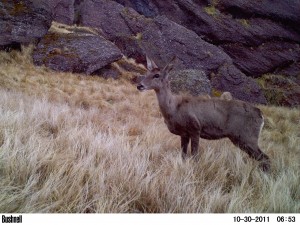 Condor Valley supports one of the most elusive and unique species of wildlife in all of Argentina. The North Andean deer (Hippocamelus antisensis), better known as the “taruka,” is a rare and little-known deer species that occupies high-elevation mountain grasslands of the Andes in southern Peru, southwestern Bolivia, northeastern Chile, and northwestern Argentina. The species is known to occupy the high-elevation grasslands of Condor Valley (CV) near Mount Creston, but details about its status remain a mystery, both at CV and throughout its range in Argentina. Few biologists have seen the species, and only anecdotal information can be offered about population characteristics and habitat needs. Despite this lack of knowledge, the taruka is considered vulnerable to extirpation, given its small numbers, isolated populations, and restricted distribution. Populations are believed to be declining in response to habitat loss, competition with non-native ungulates, predation by feral dogs, and illegal hunting. Only a few hundred individuals are thought to remain in Argentina.
Condor Valley supports one of the most elusive and unique species of wildlife in all of Argentina. The North Andean deer (Hippocamelus antisensis), better known as the “taruka,” is a rare and little-known deer species that occupies high-elevation mountain grasslands of the Andes in southern Peru, southwestern Bolivia, northeastern Chile, and northwestern Argentina. The species is known to occupy the high-elevation grasslands of Condor Valley (CV) near Mount Creston, but details about its status remain a mystery, both at CV and throughout its range in Argentina. Few biologists have seen the species, and only anecdotal information can be offered about population characteristics and habitat needs. Despite this lack of knowledge, the taruka is considered vulnerable to extirpation, given its small numbers, isolated populations, and restricted distribution. Populations are believed to be declining in response to habitat loss, competition with non-native ungulates, predation by feral dogs, and illegal hunting. Only a few hundred individuals are thought to remain in Argentina.
The species’ rare status and vulnerable status led to its designation as a “national natural monument species” by Argentina in 1996, one of just four such species assigned this status (http://www.welcomeargentina.com/parques/taruca.html); (http://turismo.idoneos.com/index.php/Turismo_Argentina/Parques_Nacionales_Arg/Especies_monumento). Designation as a natural monument is intended to draw national attention to species that are charismatic, unique, and vulnerable to extinction, and thus of keen conservation interest. The status of taruka in Argentina certainly fits these criteria. The prospect of the species’ potential disappearance from Argentina points to the urgent need for research on existing populations to document their status and trends, habitat requirements, and effects of human activities on population persistence.
In response to this need, two biologists, Gustavo Marás and Euell Macke, conducted preliminary field work at Condor Valley in October 2011 to evaluate the feasibility of studying tarukas in the area. Marás recently finished his biology degree at the University of Salta, and will be applying in June 2012 for a scholarship from the government of Argentina to study tarukas as part of a doctoral program that would begin in 2013. Macke is biologist from the United States who traveled to Condor Valley to work with Marás. The two biologists were supported in their field work by Martin Pekarek, manager of Condor Valley, his son Bruno, and gaucho Jose Ontiveros. Martin, Bruno, and Jose accompanied Marás and Macke to start the field work, providing a thorough orientation to the high-elevation grasslands, and helping haul needed supplies by horseback.
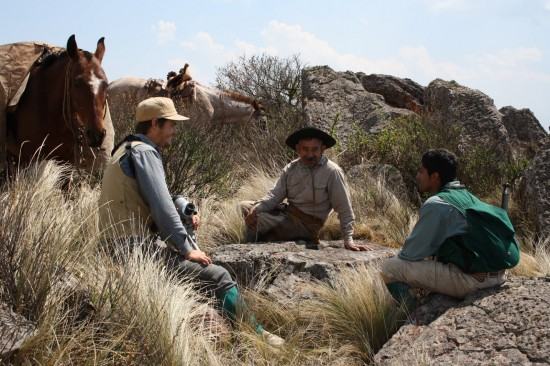
Gustavo Marás (right) and Euell Macke (left) discuss tarukas with gaucho Jose Ontiveros (center)
After a few days of orientation, Marás and Macke continued the field work on their own, with weekly reunions with the Condor Valley staff at base camps to obtain food supplies and to ensure that the logistics of the activities were safe and proceeding as planned. For nearly a month, Marás and Macke mostly camped at the highest-elevation grasslands near Mount Creston at an elevation of approximately 3,000 meters. They often lived in a cave just below Creston, from which views of a large area of taruka habitats were possible. Their daily routines typically consisted of long hikes through areas of steep, rugged terrain composed of grasslands and adjacent rocky outcrops. Grasslands are thought to be important feeding areas for tarukas, whereas the rocky outcrops are believed to be used as quick escape areas from predators. The combination of grasslands and adjacent predator escape areas is considered ideal habitat for tarukas. Preference by tarukas for grasslands in steep, boulder-strewn terrain has prompted biologists to characterize the species as the “wild sheep” member of the deer family, owing to the species’ strong affinity for the rugged, mountainous habitats that many species of wild sheep predictably use in other areas of the world.
Although Marás and Macke spent many days on foot in their search for tarukas, other days were spent on horseback, returning to lower-elevation base camps to obtain food supplies. Whether on foot or on horseback, the work was difficult and strenuous, owing to the remote, rugged landscapes. Travel on foot or horseback was necessarily slow, owing to the dangers of injury while traversing the steep, boulder-strewn terrain, which presented real hazards with every step by humans or horses.
Despite the challenges, Marás and Macke found ample evidence of tarukas in the form of tracks and feces. Samples of feces and reference plants were collected for later analysis of taruka diets. While signs of tarukas were present, Marás and Macke were not able to observe any individuals directly. This has been the main challenge for conducting taruka research: the species is extremely wary of humans, presumably because of a long history of illegal hunting. In the past, illegal hunting of tarukas at CV and surrounding ranches was probably common. Current landowners, however, are making strong efforts to remove trespassers, many of whom are suspected of illegal hunting in the past.
Marás and Macke were further supported in their search for tarukas by biologists of Argentina’s National Park Service and Salta Provincial Ministry of Environment and Sustainable Development, who conducted an aerial survey in an attempt to efficiently locate tarukas within CV and surrounding land ownerships. This aerial survey was funded by the owners of Condor Valley in partnership with the Park Service and Ministry. Although three tarukas were located on an adjacent ownership during the aerial survey, the extremely steep, dissected terrain makes aerial surveys inefficient and inaccurate for locating tarukas, who can easily hide from view in such terrain. Effective surveys are thus limited to flatter ridgetops, which compose only a portion of taruka habitat, and which could be avoided by tarukas in response to the disturbance posed by aerial flights. Guidance and advice from the Park Service and Ministry biologists, as well as biologists from Argentina’s National Wildlife Service, will continue to be an important part of the support for Marás’ Ph.D. program of study.
Although Marás and Macke were not able to observe tarukas directly during the initial month of study, they set up five trail cameras in areas where fresh tracks and feces were found, or in other areas where habitat conditions appeared most suitable. The trail cameras were loaned to the project from the University of Salta. The cameras recorded photos of all animals in the field of view on a systematic basis, operating for over a month before batteries had to be recharged. The use of trail cameras is a relatively new method in wildlife research. The method has proven especially effective for the study of rare and elusive wildlife that typically cannot be observed directly. Trail cameras are especially effective for studies of such elusive species in remote, rugged terrain where human travel is difficult and inefficient. All of the above characteristics aptly describe the situation for tarukas and their habitats at Condor Valley.
After leaving the trail cameras to operate for over a month in the field, Marás returned in mid-December of 2011 with the staff of CV to retrieve the cameras and examine the photos. Just four days after the cameras had been set up, one of the cameras captured photos of a group of at least 5 tarukas, 3 females and 2 males. The camera had been located in the same area in which Marás and Macke had spent much of their time, verifying that use of trail cameras can provide an accurate means of research on animals that are difficult to observe directly.
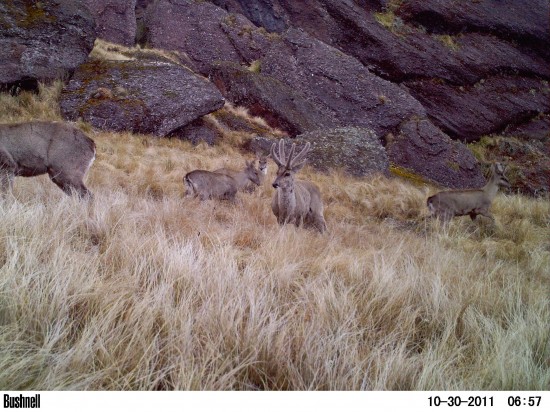 Marás is now developing a formal proposal to study tarukas as part of his doctoral program. The proposal will partially rely on new methods of using trail cameras to evaluate population characteristics of tarukas and to evaluate habitat use by the species at Condor Valley. Up to 100 trail cameras may be needed to saturate study areas with cameras. The high number of cameras is needed to obtain sufficient spatial coverage to accurately estimate population characteristics such as population size, sex and age ratios, and productivity. Such sampling with the trail cameras would occur at CV and possibly one additional study area.
Marás is now developing a formal proposal to study tarukas as part of his doctoral program. The proposal will partially rely on new methods of using trail cameras to evaluate population characteristics of tarukas and to evaluate habitat use by the species at Condor Valley. Up to 100 trail cameras may be needed to saturate study areas with cameras. The high number of cameras is needed to obtain sufficient spatial coverage to accurately estimate population characteristics such as population size, sex and age ratios, and productivity. Such sampling with the trail cameras would occur at CV and possibly one additional study area.
Systematic use of the trail cameras also is essential for characterizing areas of habitat use versus areas available to tarukas but not documented as used. This type of habitat characterization can be accomplished by measuring a wide variety of habitat conditions across camera sites, and analyzing differences in conditions at the camera sites where tarukas are recorded, versus habitat conditions at camera sites were no taruka use is documented, as estimated for each season of year. This type of habitat analysis with trail cameras is novel but evolving rapidly as a powerful tool for understanding habitat use and habitat needs of rare and elusive wildlife such as the taruka.
Other potential threats to taruka persistence, such as the presence of European boars (Sus scrofa) and pumas (Puma concolor), can also be evaluated with use of the trail cameras. In particular, the combination of European boars, overhunting by humans, and predation may pose a synergistic challenge to persistence of tarukas. European boars, native to Europe and introduced to Argentina for hunting, are now established and common across most taruka range. Boars aggressively defend water sites from use by other wildlife, and have been known to displace native mammals from their habitats, even sometimes killing native mammals outright with their aggressive, pack-based behavior. In addition, boars often compete directly with native ungulates for food, or indirectly change the availability of food through uprooting and removal of vegetation, an activity that typifies the species’ foraging behavior. These deleterious effects can reduce population numbers of native ungulates and substantially reduce the areas that otherwise would be used as habitat by other ungulates.
When such potential effects from boars are combined with overhunting, native ungulates can be reduced in number to a level where a population is vulnerable to extirpation by predators. Although feral dogs have not been documented within taruka range at Condor Valley, the native population of pumas appears healthy and is thought to be increasing. Under these conditions, predation by a native predator such as puma may pose major problems for a small population of taruka such as what is believed to exist at Condor Valley and adjacent land ownerships. Trail cameras could be used effectively to document the distribution, population characteristics, and habitat use by European boars and pumas in relation to these same types of estimates derived for tarukas to understand the potential inter-specific relations among the three species.
In addition to the use of trail cameras, the proposed research by Marás would focus on collection of samples of feces at the used camera sties to estimate the food habitats of tarukas by season of year. Samples of hair from the tarukas, which also can be obtained at the camera sites used the by the species, would be analyzed to evaluate genetic diversity of the population. Small, isolated populations of an animal species often have low genetic diversity, in contrast to the higher diversity typical of larger, well-connected populations. This type of genetic analysis provides insights about the degree to which a smaller, isolated population may be vulnerable to extirpation from inbreeding and other negative effects of low genetic diversity.
Preliminary field work will continue in 2012, assuming that additional trail cameras can be obtained and placed in areas of potential taruka use. A number of grant proposals will be submitted to international conservation organizations to support the work. Success at obtaining these grants, in combination with Marás being awarded a research scholarship, will determine the pace at which future research occurs.
Effective collaboration with the Condor Valley staff also is essential to the future success of taruka research at CV. Without the support from the Condor Valley staff and ownership, taruka research in the area would not be possible. Another key to continued success is securing continued help from skilled field biologists such as Macke, who wants to return to Condor Valley to help with future work and to possibly pursue a graduate study for himself on the taruka. Updates about research progress on the taruka project will be provided on the Condor Valley website as work continues on this exciting and novel research.
Michael Wisdom and Ricardo Ojeda are coordinating the development of taruka research at Condor Valley. The two scientists each have over 30 years of research experience in the study of mammals and other wildlife. Wisdom can be contacted at mwisdom@fs.fed.us, and Ojeda at rojeda@mendoza-conicet.gov.ar.

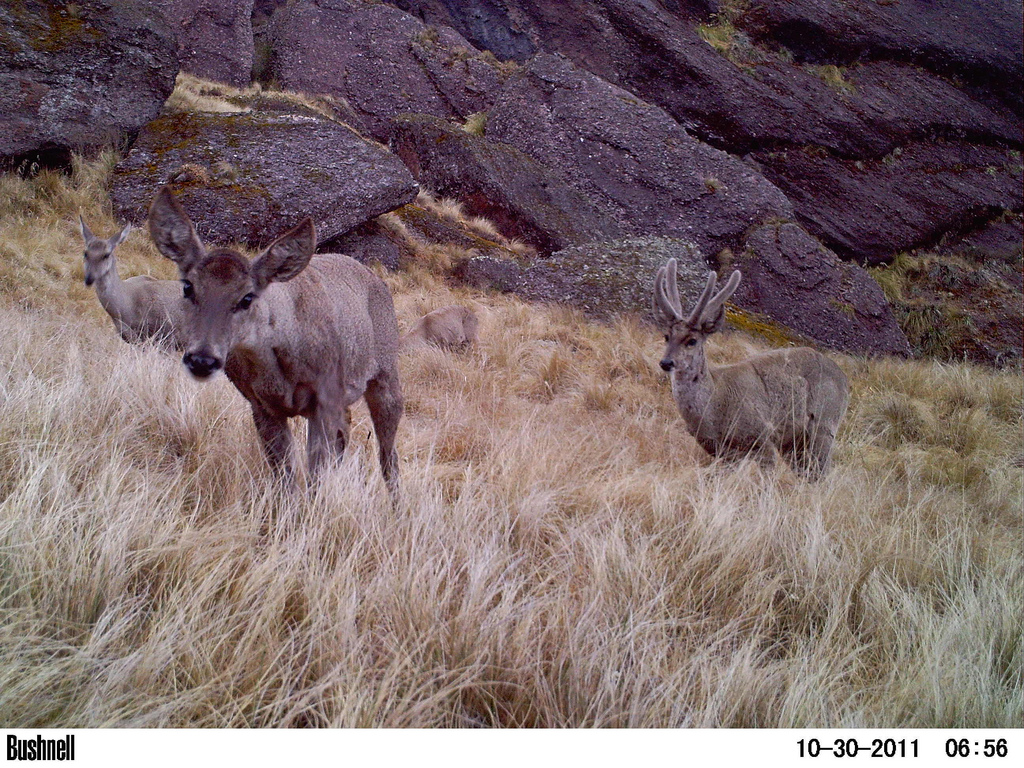
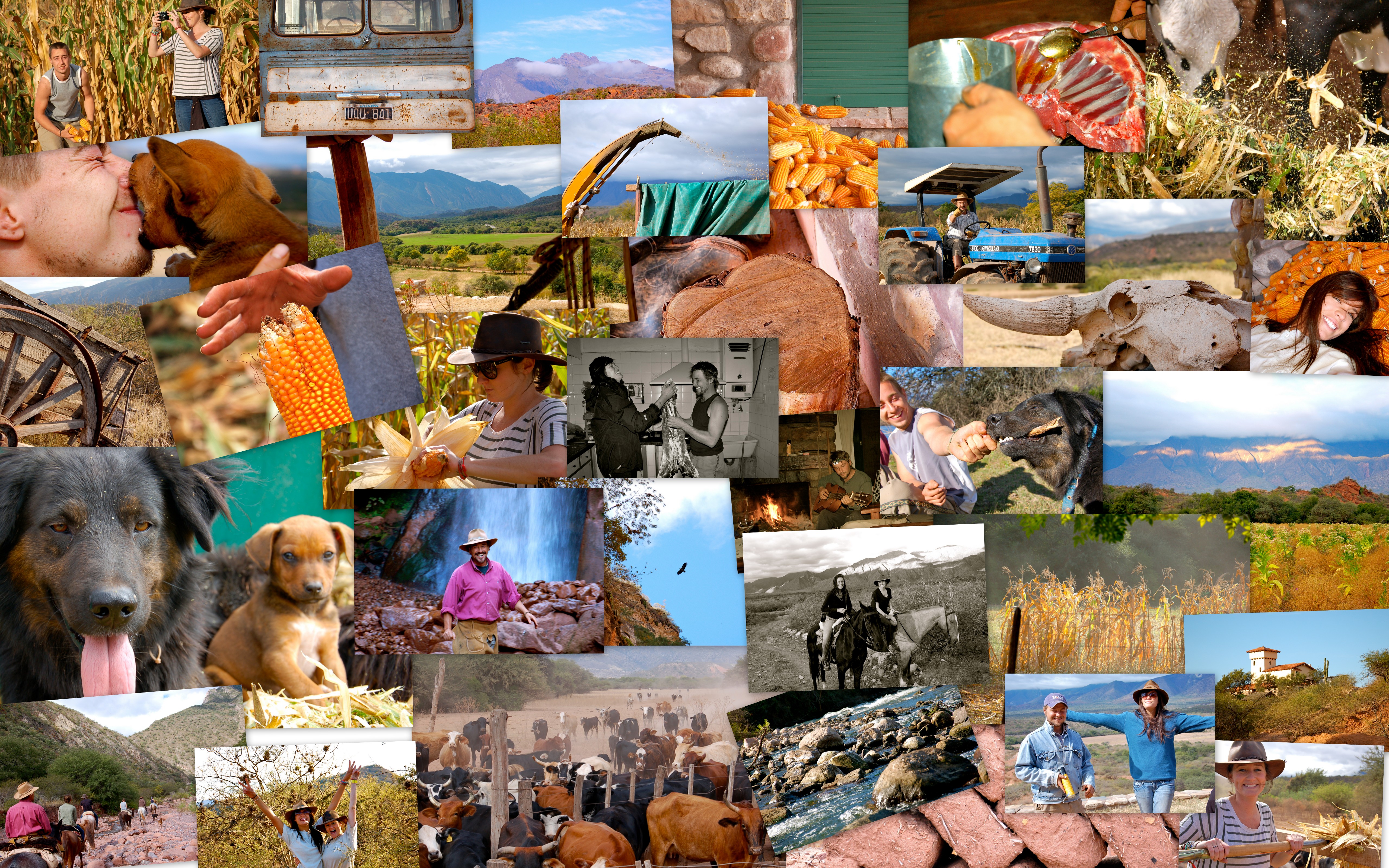
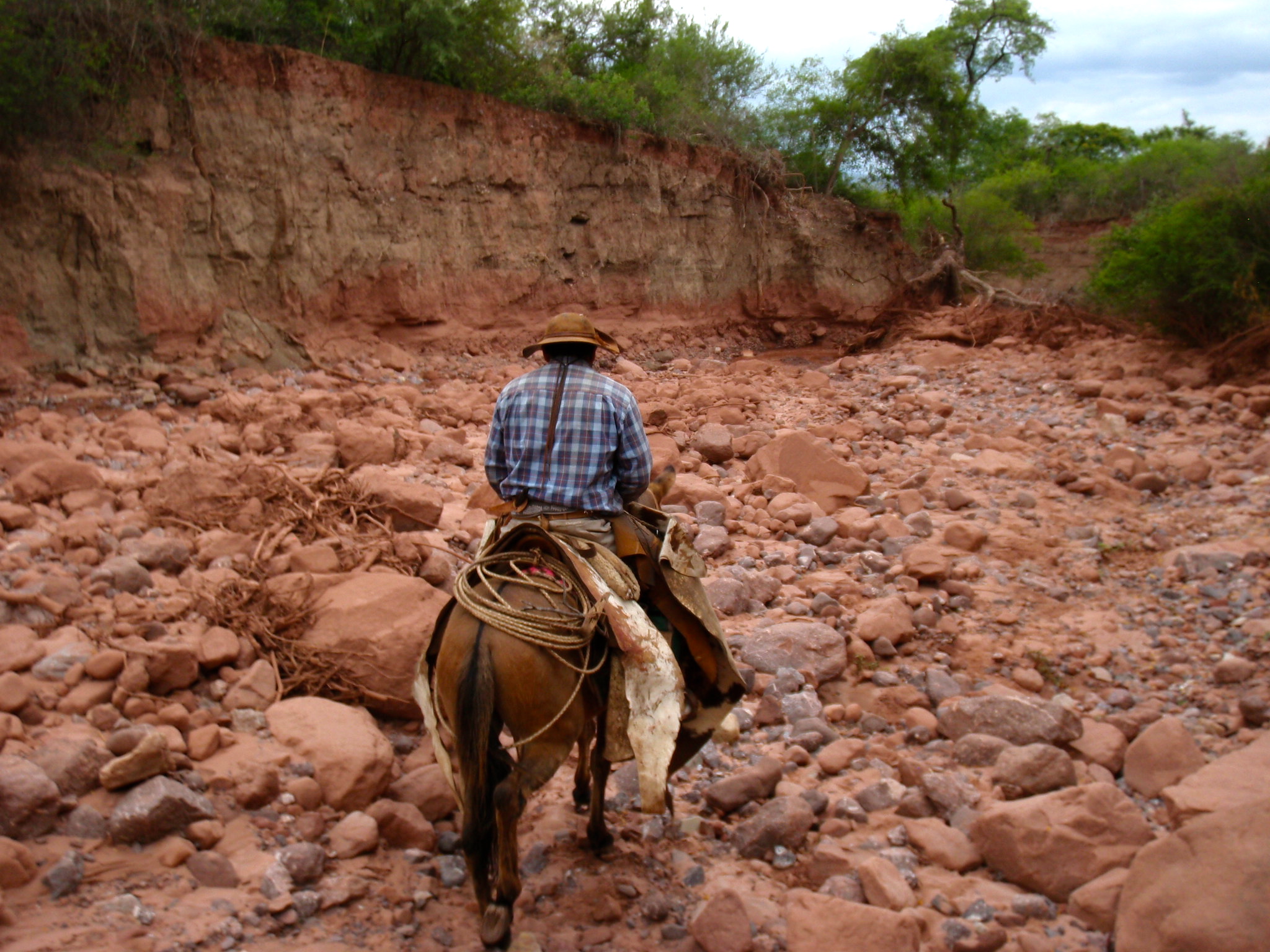
No Comments